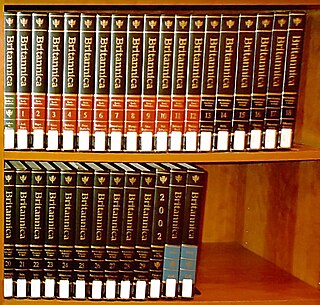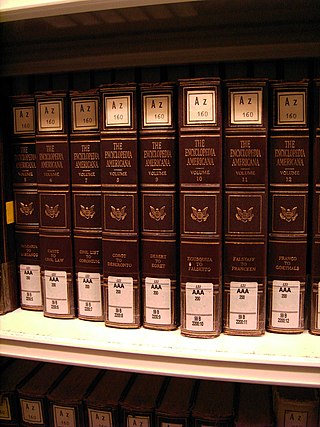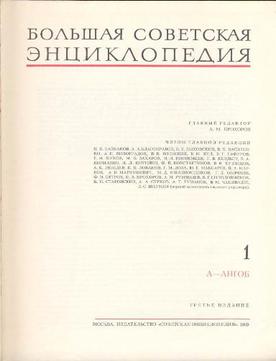
An encyclopedia or encyclopædia is a reference work or compendium providing summaries of knowledge either general or special to a particular field or discipline. Encyclopedias are divided into articles or entries that are arranged alphabetically by article name or by thematic categories, or else are hyperlinked and searchable. Encyclopedia entries are longer and more detailed than those in most dictionaries. Generally speaking, encyclopedia articles focus on factual information concerning the subject named in the article's title; this is unlike dictionary entries, which focus on linguistic information about words, such as their etymology, meaning, pronunciation, use, and grammatical forms.

Encyclopedia Americana is a general encyclopedia written in American English. It was the first major multivolume encyclopedia that was published in the United States. With Collier's Encyclopedia and Encyclopædia Britannica, Encyclopedia Americana became one of the three major English-language general encyclopedias; the three were sometimes collectively called "the ABCs". Following the acquisition of Grolier in 2000, the encyclopedia has been produced by Scholastic.

The Great Soviet Encyclopedia is the largest Soviet Russian-language encyclopedia, published in the Soviet Union from 1926 to 1990. After 2002, the encyclopedia's data was partially included into the later Boljšaja rossijskaja enciklopjedija in an updated and revised form. The GSE claimed to be "the first Marxist–Leninist general-purpose encyclopedia".

Everyman's Library is a series of reprints of classic literature, primarily from the Western canon. It is currently published in hardback by Random House. It was originally an imprint of J. M. Dent, who continue to publish Everyman Paperbacks.

Chambers's Encyclopaedia was founded in 1859 by William and Robert Chambers of Edinburgh and became one of the most important English language encyclopaedias of the 19th and 20th centuries, developing a reputation for accuracy and scholarliness that was reflected in other works produced by the Chambers publishing company. The encyclopaedia is no longer produced. A selection of illustrations and woodblocks used to produce the first two editions of the encyclopaedia can be seen on a digital resource hosted on the National Museums Scotland website.
The English Cyclopaedia: A new dictionary of universal knowledge, was published by Charles Knight, based on the Penny Cyclopaedia, of which he had the copyright. He was assisted by Alexander Ramsay and James Thorne. It was sometimes popularly referred to as Knights Encyclopedia.

Collier's Encyclopedia is a discontinued general encyclopedia first published in 1949 by P. F. Collier and Son in the United States. With Encyclopedia Americana and Encyclopædia Britannica, Collier's Encyclopedia became one of the three major English-language general encyclopedias. The three were sometimes collectively called "the ABCs". In 1998, Microsoft acquired the right to use Collier's Encyclopedia content from Atlas Editions, which had by then absorbed Collier Newfield. Microsoft incorporated Collier's Encyclopedia's content into its Encarta digital multimedia encyclopedia, which it marketed until 2009.

The Enciclopedia universal ilustrada europeo-americana is a Spanish encyclopedia. It comprises 72 volumes published from 1908 to 1930 plus a ten-volume appendix published 1930–33. Between 1935 and 2003, 33 supplemental volumes were published plus an index, another A–Z appendix, and an atlas, for a total of 118 volumes. Each of the volumes vary in length. As of 1986, it is the longest printed encyclopedia with 105,000 pages and 165,200,000 words.
Compton's Encyclopedia and Fact-Index is a home and school encyclopedia first published in 1922 as Compton's Pictured Encyclopedia. The word "Pictured" was removed from the title with the 1968 edition. The encyclopedia is now advertised as Compton's by Britannica.
The New International Encyclopedia was an American encyclopedia first published in 1902 by Dodd, Mead and Company. It descended from the International Cyclopaedia (1884) and was updated in 1906, 1914 and 1926.
The New Book of Knowledge is an encyclopedia published by Grolier USA.
Academic American Encyclopedia is a 21-volume general English-language encyclopedia published in 1980. It was first produced by Arête Publishing, the American subsidiary of the Dutch publishing company VNU.
The Lincoln Library of Essential Information was originally published as a one-volume general-reference work, in 1924. In later years, it was published in two- and three-volume editions, and the title was changed.
This is intended to be as comprehensive a list as possible of encyclopedias and encyclopedic/biographical dictionaries ever published in any language. The list will not include reprinted editions but it is intended to list an alphabetical bibliography by theme and language to anything which resembles an A–Z encyclopedia or encyclopedic dictionary, both print and online. Entries are in the English language unless specifically stated as otherwise. Several entries may overlap and be listed under several different topics. For a simple list without bibliographic information see Lists of encyclopedias.
American Educator was the most common name for an encyclopedia set that was published in the United States from 1901 to the 1970s.
The New Standard Encyclopedia was the most common name for an encyclopedia that ran from 1910 to the mid-1960s.
The Human Interest Library was a children's encyclopedia published from the 1910s to at least the mid-1960s.
Our Wonder World was a children's encyclopedia published from the 1910s to the mid-1960s, under a variety of names.
The Volume Library was a one volume general encyclopedic reference work that was published from 1911 to 1985. It remained as a two or three volume reference work until at least 2004.
Collins Concise Encyclopedia was the most common name for an encyclopedia that was published in various formats and names from 1921 until at least the early 1990s.







